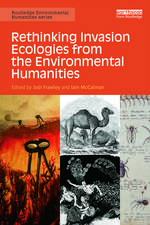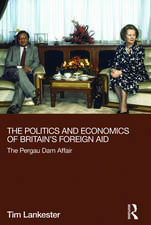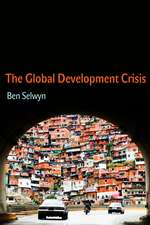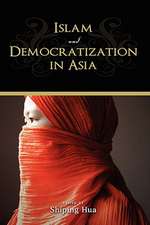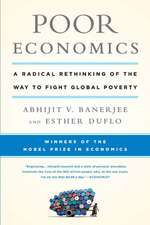East Asian Development Model: Twenty-first century perspectives: Routledge Contemporary Asia Series
Editat de Shiping Hua, Ruihua Huen Limba Engleză Paperback – 24 mai 2017
Bearing this in mind, is it even possible to formulate an East Asian development model in the context of a shifting twenty-first century? And if so, what is it? This book addresses this issue by looking at the economic, political and cultural perspectives of China, Japan and South Korea, focusing on dynamism and potential consensus regarding an East Asian development model. The chapters offer a historical background to the East Asian development model, as well as in-depth case studies of each of the countries concerned to show that whilst the East Asian development model does have distinct characteristics as compared with other areas, and other countries may draw some insights from the East Asian experience, it is not a panacea that fits all circumstances and fits all times.
This book will be welcomed by students and scholars of Asian economics, Asian politics, international political economy and development studies.
| Toate formatele și edițiile | Preț | Express |
|---|---|---|
| Paperback (1) | 447.51 lei 43-57 zile | |
| Taylor & Francis – 24 mai 2017 | 447.51 lei 43-57 zile | |
| Hardback (1) | 1166.80 lei 43-57 zile | |
| Taylor & Francis – 17 dec 2014 | 1166.80 lei 43-57 zile |
Din seria Routledge Contemporary Asia Series
- 18%
 Preț: 702.95 lei
Preț: 702.95 lei -
 Preț: 351.55 lei
Preț: 351.55 lei -
 Preț: 325.78 lei
Preț: 325.78 lei - 9%
 Preț: 1003.31 lei
Preț: 1003.31 lei - 23%
 Preț: 327.54 lei
Preț: 327.54 lei - 18%
 Preț: 1057.89 lei
Preț: 1057.89 lei - 28%
 Preț: 821.29 lei
Preț: 821.29 lei -
 Preț: 412.57 lei
Preț: 412.57 lei -
 Preț: 396.14 lei
Preț: 396.14 lei - 18%
 Preț: 1064.70 lei
Preț: 1064.70 lei - 18%
 Preț: 1060.87 lei
Preț: 1060.87 lei - 18%
 Preț: 1057.40 lei
Preț: 1057.40 lei -
 Preț: 114.30 lei
Preț: 114.30 lei - 25%
 Preț: 825.06 lei
Preț: 825.06 lei - 49%
 Preț: 543.60 lei
Preț: 543.60 lei - 18%
 Preț: 1063.89 lei
Preț: 1063.89 lei -
 Preț: 248.10 lei
Preț: 248.10 lei - 28%
 Preț: 821.53 lei
Preț: 821.53 lei - 18%
 Preț: 704.83 lei
Preț: 704.83 lei - 18%
 Preț: 1061.84 lei
Preț: 1061.84 lei -
 Preț: 363.20 lei
Preț: 363.20 lei -
 Preț: 488.71 lei
Preț: 488.71 lei - 18%
 Preț: 1058.43 lei
Preț: 1058.43 lei - 18%
 Preț: 1058.10 lei
Preț: 1058.10 lei - 18%
 Preț: 1060.87 lei
Preț: 1060.87 lei - 18%
 Preț: 1064.01 lei
Preț: 1064.01 lei - 18%
 Preț: 1050.09 lei
Preț: 1050.09 lei - 18%
 Preț: 1061.06 lei
Preț: 1061.06 lei - 18%
 Preț: 706.78 lei
Preț: 706.78 lei - 18%
 Preț: 1055.51 lei
Preț: 1055.51 lei - 14%
 Preț: 298.61 lei
Preț: 298.61 lei -
 Preț: 364.94 lei
Preț: 364.94 lei - 18%
 Preț: 733.20 lei
Preț: 733.20 lei -
 Preț: 416.96 lei
Preț: 416.96 lei - 18%
 Preț: 1057.13 lei
Preț: 1057.13 lei - 18%
 Preț: 1057.05 lei
Preț: 1057.05 lei - 18%
 Preț: 1276.26 lei
Preț: 1276.26 lei - 18%
 Preț: 1057.05 lei
Preț: 1057.05 lei - 18%
 Preț: 1061.93 lei
Preț: 1061.93 lei - 18%
 Preț: 1109.99 lei
Preț: 1109.99 lei - 18%
 Preț: 732.06 lei
Preț: 732.06 lei -
 Preț: 398.18 lei
Preț: 398.18 lei
Preț: 447.51 lei
Nou
Puncte Express: 671
Preț estimativ în valută:
85.63€ • 89.65$ • 70.85£
85.63€ • 89.65$ • 70.85£
Carte tipărită la comandă
Livrare economică 07-21 aprilie
Preluare comenzi: 021 569.72.76
Specificații
ISBN-13: 9781138295254
ISBN-10: 1138295256
Pagini: 284
Ilustrații: 42
Dimensiuni: 156 x 234 x 18 mm
Greutate: 0.41 kg
Ediția:1
Editura: Taylor & Francis
Colecția Routledge
Seria Routledge Contemporary Asia Series
Locul publicării:Oxford, United Kingdom
ISBN-10: 1138295256
Pagini: 284
Ilustrații: 42
Dimensiuni: 156 x 234 x 18 mm
Greutate: 0.41 kg
Ediția:1
Editura: Taylor & Francis
Colecția Routledge
Seria Routledge Contemporary Asia Series
Locul publicării:Oxford, United Kingdom
Public țintă
Postgraduate and UndergraduateCuprins
Part I: Theoretical Perspectives 1. Introduction: The East Asian Development Model 2. Need for a Paradigm Change for the East Asian Economy Part II: The Republic of Korea 3. The Use of Nationalist Ideology in the Economic Development of South Korea: Implications for East Asian Development Model 4. Democratic Development and Authoritarian Development Compared: South Korea 5. Japan-South Korea Economic Ties: Stability and Growth through Discord Part III: Japan 6.The Development of Japan’s Developmental State: Stages of Growth and the Social Costs of Energy and Export Promotion Policies 7. A Tale of Two Capitalisms: Developmentalism, Neoliberalism and the Japanese Postal System 8. The Political Economy of Digital Television Transition in Japan and the United States: How Well Can a Coordinated Market Economy Solve a Coordination Problem? Part VI: The People’s Republic of China 9.The Beijing Consensus, the World Capitalist System and the Limits of Globalization 10. China’s Development Path: Joys and Worries 11. Two Models of Economic Development in China 12. The Mass Line Model: East Asian Democratic Model 13. Beyond Win-Win: Rethinking China’s International Relationships In an Era of Economic Uncertainty
Notă biografică
Shiping Hua is Calvin and Helen Lang Distinguished Chair in Asian Studies and Director of the Asian Studies Program, at the University of Louisville, USA. He is also "100-Plan Scholar" with Xi’an International Studies University, China.
Ruihua Hu is Dean of the School of International Studies, Xi’an International Studies University, China.
Ruihua Hu is Dean of the School of International Studies, Xi’an International Studies University, China.
Descriere
Since the turn of the century there have been major changes across the economies of East Asia, as Japan has experienced two decades of economic slow-down, while China has become the second largest economy in the world. Bearing this in mind, is it even possible to formulate an East Asian development model in the context of a shifting 21st century? And if so, what is it? This volume addresses this issue of by looking at the economic, political and cultural perspectives of China, Japan and South Korea, focusing on dynamism and potential concensus regarding an East Asian development model.










